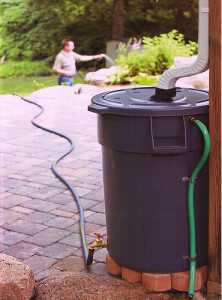Rain Barrels: Easy & Economical
One of the most striking features of the Lady Bird Johnson Wildflower Center in Austin, Texas, is the rainwater harvesting system, which includes a handsome native-limestone aqueduct, cistern, and ponds that collect and store more than 10,000 gallons of water for every inch of rain that falls. Such an extensive system is an expensive, long-term investment, but a simple rain barrel in your own back yard is an easy, inexpensive way to conserve water by capturing rain from downspouts.
Rain barrels and rainwater collection systems allow you to save rainwater to use at your convenience instead of watering the garden with tap water. If you live in an area where watering is restricted, a rain barrel gives you the flexibility to water any time. Rainwater is softer than city water, and it doesn’t contain chlorine, fluoride, or other chemicals: plants thrive on rainwater. Rain barrels also help limit runoff, reducing pressure on storm-water drainage systems.
Collecting rainwater is as simple as diverting water from a downspout into a vessel. It only takes about one-fourth inch of rain to fill a typical 50-gallon barrel. Rain barrels are usually installed with a diverter, to send water from the downspout into the barrel. When the barrel fills up, water runs through the downspout as usual, and the overflow area is often an ideal spot for a rain garden. Some diverters are fitted with a filter, to keep leaves and other debris from getting into the barrel; all rain barrels should have a mosquito screen.
Rain barrels typically have a spigot for filling a watering can or a place to attach a hose, or both. Since gravity drains the barrel, a hose attachment is usually at the bottom of the barrel. A 50-gallon barrel full of water weighs 400 pounds, so find a level spot and raise the barrel on a couple of cinder blocks to create a little clearance for the spigot and to keep it from settling in wet soil.
Home-garden irrigation amounts to about 40 percent of residential water use. With a full rain barrel, you can water all the planters on the porch or patio, refresh the zinnias and sunflowers in the sunny flower bed nearby, and still have enough to water them all again a few days later, without turning on a tap.














Social